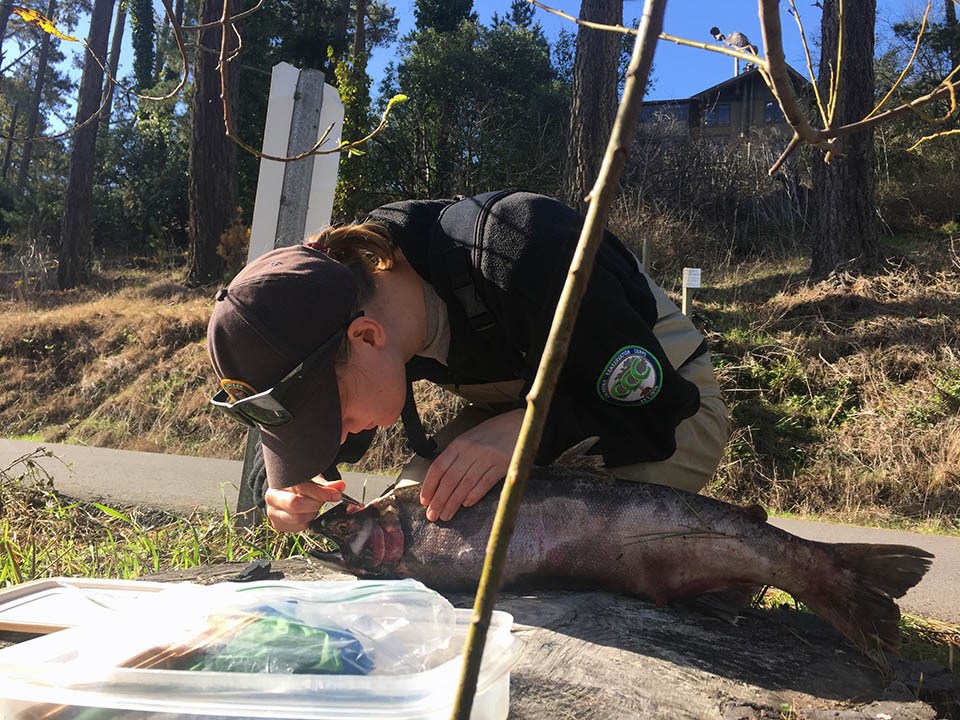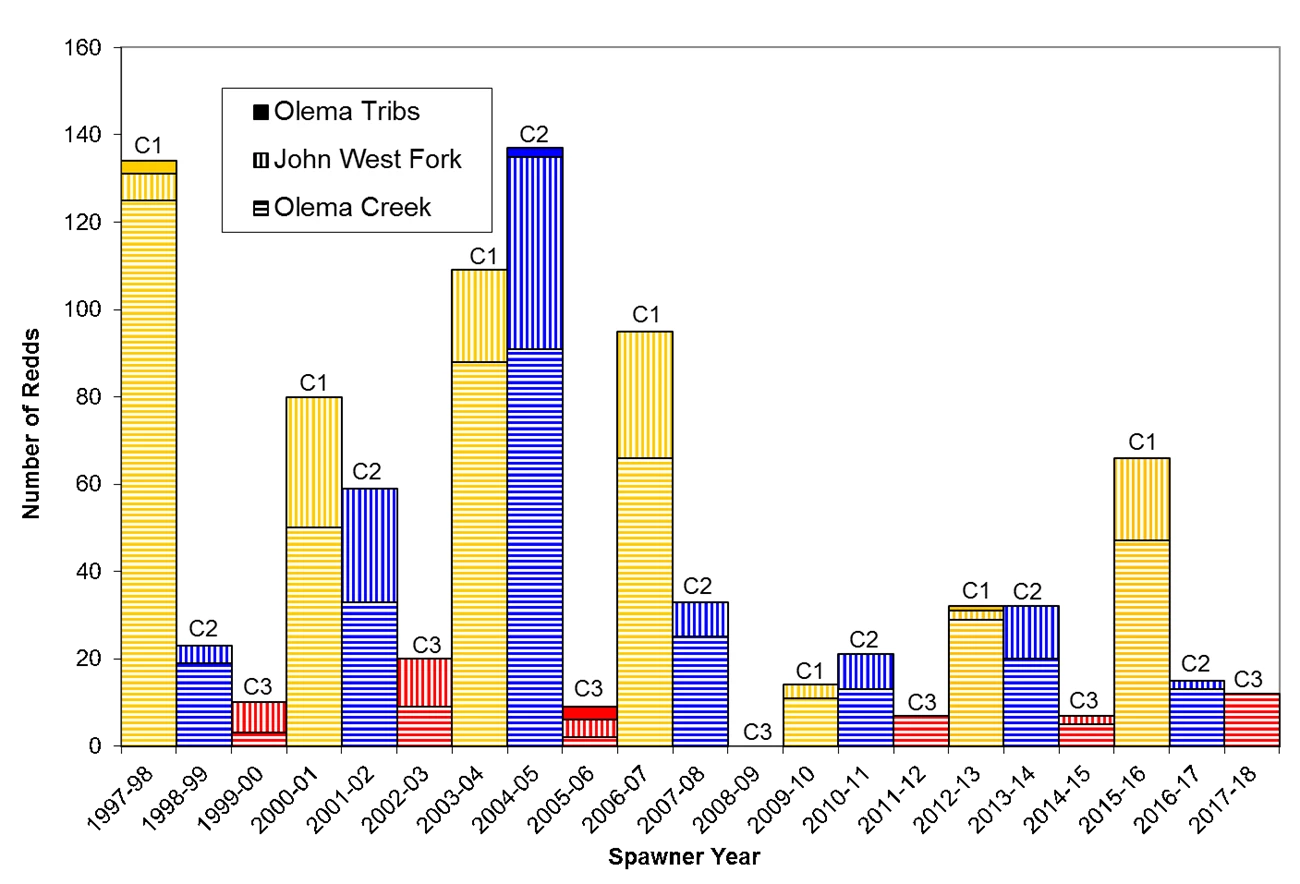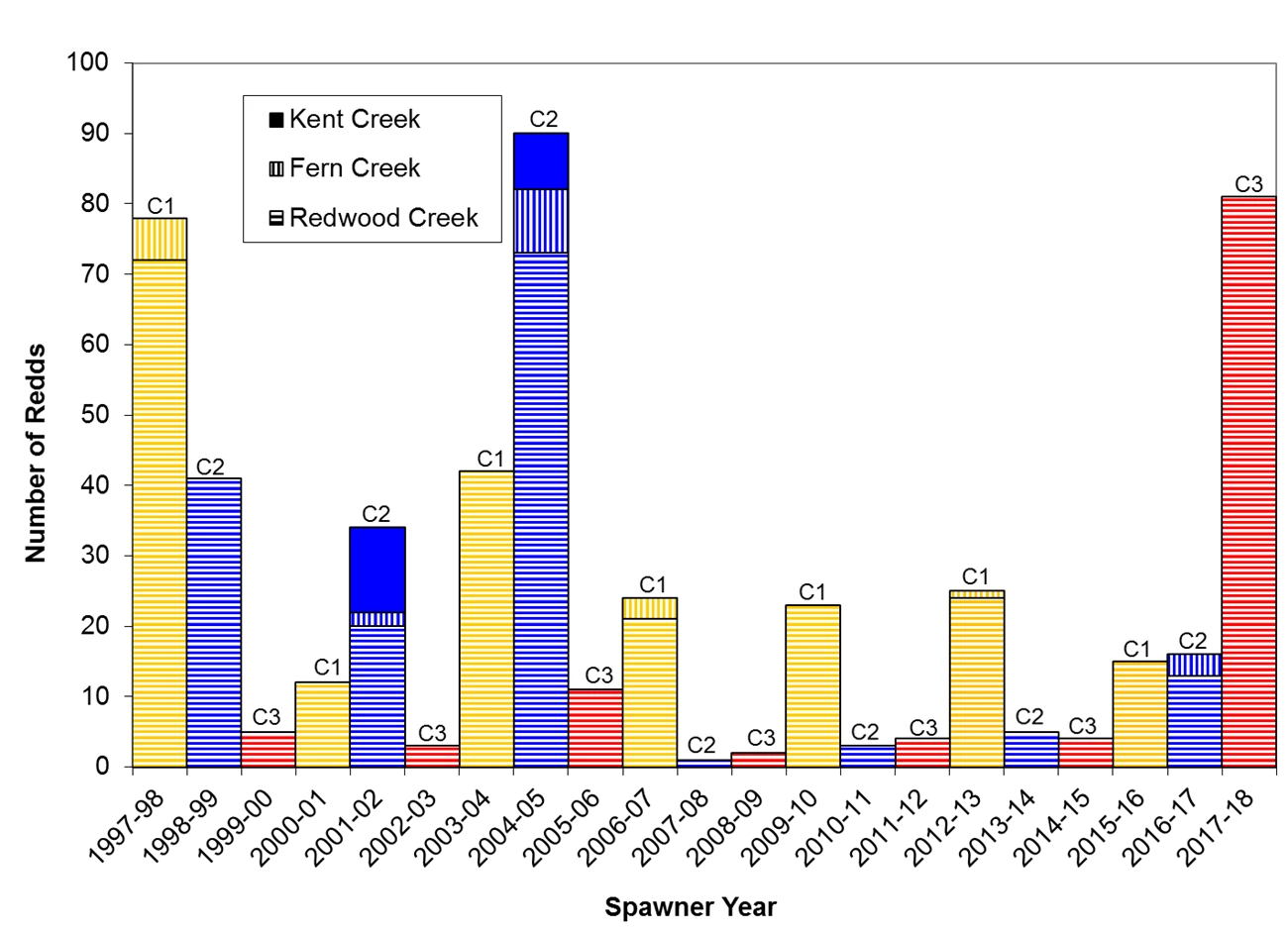Last updated: July 8, 2025
Article
Winter 2017-2018 Coho and Steelhead Spawner Survey Summary
A big thanks to all of our volunteers who participated in the 2017-2018 Coho and Steelhead Spawner Surveys! Through your dedication and flexibility, we were able to successfully complete all of our spawner surveys.
2017-2018 Spawner Season Overview
Going on now!
Although our spawner season has come to a close, monitoring of coho and steelhead in West Marin marches on. Smolt trapping is underway and will continue through the month of May. The goal of the smolt trap is to estimate the number and health of coho salmon going out to sea. After leaving the creek these salmon will continue rearing in the ocean as they mature to adults. Smolt trapping is an excellent opportunity to monitor and handle a wide variety of aquatic species including coho salmon, steelhead, stickleback, sculpin, salamanders…and a whole lot more!
Coho salmon are three years old when they return to their natal stream to spawn. These spawners are the offspring of coho that spawned three years prior, and the parents of the generation that will spawn in another three years. As a result, there are three distinct year classes, or cohorts, of coho salmon spawners in each creek, each with its own population trends that may only be tracked every third year. The 2017-2018 spawner cohort is primarily descended from coho that spawned in the winter of 2014-2015.
Data from the Olema Valley rain gage indicate that this winter, Marin County saw its driest December in over 20 years, and the second driest December since 1965. During the second week of January, we finally received significant rainfall with the Olema gage recording over four inches of rain. With access to spawning grounds, both coho and steelhead adults were observed moving upstream to spawn. Adult coho were also released into Redwood Creek to take advantage of the ideal spawning conditions. A long dry spell followed, with only one inch of rain falling from the end of January to the end of February.

NPS / Priscilla Sisommout
In a typical year, the coho spawning run would span over two months (December to early February), but this year it was confined to only three weeks. Despite the short spawning window, Olema Creek redd (nest) production increased by 70% from the winter of 2014-2015. On Redwood Creek, the increase in the number of redds was bolstered by the release of adult coho into the system. At a minimum, we documented four redds prior to the release, and field observations indicate that there was likely additional spawning of wild coho after the release. No live coho or confirmed coho redds were observed on Pine Gulch or Cheda Creeks. We will perform juvenile surveys in the summer of 2018 to validate spawner counts in Olema, Pine Gulch, and Redwood Creeks.
Preliminary Spawner Season Details
Although this season’s coho spawner surveys are complete, a handful of adult coho remain in Redwood Creek, and some steelhead spawner surveys are still ahead. The totals reported below are preliminary, pending review. It should also be noted that live adult coho and steelhead totals may include repeat sightings.
Redwood Creek
On January 12, 188 coho (89 females, 87 males, and 12 precocious male “jacks”) were released back into Redwood Creek to spawn as part of the Redwood Creek Coho Salmon Rescue and Captive Rearing Project. These fish were captured in the creek as juveniles and reared to adulthood at the Don Clausen Fish Hatchery in Sonoma County.
We observed 18 live coho and four coho redds on Redwood Creek prior to the release. In total, we counted 193 live coho, 23 coho carcasses, and 81 coho redds, with an additional 11 redds that were unidentifiable to species. Of the 193 live fish we saw, at least 130 were hatchery fish, identified by colored tags attached near their dorsal fins. Eleven adult steelhead, two steelhead carcasses, and three confirmed steelhead redds were also observed.
Olema Creek
We encountered the first live coho in Olema Creek on January 11, and the last on January 29. The majority of our coho redd observations also occurred during that time. In total, we counted 83 live adult coho, 14 coho carcasses, and 12 coho redds on Olema Creek. In addition to coho observations, we recorded 24 live adult steelhead, one steelhead carcass, and 13 steelhead redds. Two redds were documented for which species could not be determined.
Pine Gulch and Cheda Creeks
No coho were observed on Cheda Creek, although two unknown redds and pieces of a salmonid carcass were recorded. One unknown redd was recorded on Pine Gulch Creek.
Trends in Coho Salmon Spawning
The 2017-2018 cohort on Olema has held fairly steady over the last two generations (seven redds in 2011-2012, and six redds in 2014-2015) with a somewhat modest increase this season. In comparison, the 2017-2018 cohort on Redwood Creek rose dramatically with the successful release of the hatchery-raised adults. Given the high number of hatchery-origin adult coho observed spawning, a much larger juvenile population is anticipated this summer than would have been expected from natural production. Although we have documented successful spawning by the released adult coho, the true test will come in future generations of this cohort and its ability to persist. Despite observed spawning in Cheda Creek, overall abundance in this small tributary to Lagunitas Creek remains low. Pine Gulch Creek continues to show no sign of coho spawning activity. For annual coho redd counts observed on Olema and Redwood Creeks over the last 20 years, please see Figures 1 & 2 below.


For More Information
For more information about the San Francisco Bay Area Coho and Steelhead Monitoring Program, contact Michael_Reichmuth@nps.gov or call 415-464-5191.
The National Park Service shall not be held liable for improper or incorrect use of the data described and/or contained herein. These data and related graphics (if available) are not legal documents and are not intended to be used as such. The information contained in these data is dynamic and may change over time. The National Park Service gives no warranty, expressed or implied, as to the accuracy, reliability, or completeness of these data.

